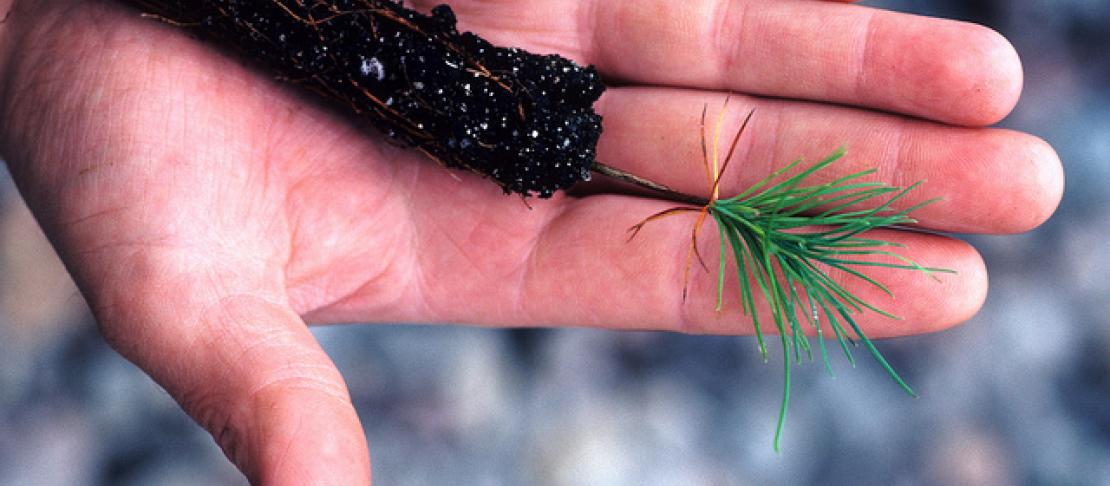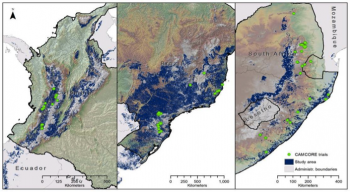How will your forest grow? Climate Analogues provides clues for pine plantation adaptation

By Caity Peterson
Forestry isn’t generally thought of as a game of chance. That designation is usually reserved for cards, horse races, and Parcheesi tournaments. But, when one throws in the volatile variable of a changing climate, the process of tree caretaking becomes an intimidating gamble.
Christoph Leibing, a PhD candidate at the University of Hamburg Centre for Wood Science and Technology, Hamburg, Germany, presented his work last week, February 5, 2013 at the IUFRO Breeding for Value in a Changing World Conference in Jacksonville, Florida. The paper, “Selection of provenances to adapt tropical pine forestry to climate change on the basis of climate analogues,” represents the first published example of the CCAFS Climate Analogues tool in use — a landmark achievement.
Farmers are gamblers, too, come to think of it. An investment made in a new variety of maize for this year’s crop could quickly go belly-up if conditions change unexpectedly. But what’s tough for farmers is even tougher for foresters, as the latter are banking on a 10-20 year investment rather than a yearly one. Picking the wrong variety of tree could have repercussions well into the future.
That’s where Climate Analogues comes in. The tool, developed in 2011 by a team from the International Center for Tropical Agriculture (CIAT) and the Walker Institute at the University of Reading (see the original working paper), calculates climate dissimilarities to find the areas of the globe with a climate that is similar to the current or future climate of a reference site. Climate Analogues could be an extremely valuable tool in the forester’s belt, not only helping to locate areas of highest suitability for a timber species with desirable characteristics (volume, resistance to disease, high survival rates), but identify what kind of tree should be planted now that will be resilient to climate changes 10 years in the future. Cool, huh?
Leibing and his co-authors’ delightfully elegant approach makes use of a database of 153 pine provenance trials established from 1981 to 1997 in three different countries—Colombia, Brazil and South Africa— by the International Tree Breeding and Conservation Program (Camcore) at North Carolina State University. As Leibing explained to conference-goers, the combination of these trials with the climate data from Analogues provided a useful way to “predict” how two economically important pine plantation species, Pinus tecunumanii and Pinus patula, might respond as the climate changes.

When the climate dissimilarities among all the trial sites were calculated by Analogues and then paired with the growth performance of the trees, the result was a way to see how height growth is likely to change as the climate gets further and further away from the optimum. The growth predictor could then project changes in tree performance under various future climate change scenarios.
As it turns out, P. tecunumanii and P. patula have two very different personalities when it comes to dealing with long-term climate change. While P. tecunumanii may be a world class sprinter—a high performer under the right circumstances— P. patula is the slightly slower but more versatile decathlon star. That is, the first variety has desirable characteristics but is sensitive to change and must be grown under very restricted climatic conditions, while the other tends to be flexible and could be planted today with the knowledge that, should things change 10 years down the line, its performance won’t be affected too much.
If I’m a forester, and I’m no good at counting cards, that’s a mighty useful bit of information. The hope is that, with this tool in hand, forests can continue to be healthy and productive even in the face of unpredictable climate change and variability. Foresters, scientists, and anyone who thinks paper and wood products are sort of necessary, never fear—Climate Analogues is here!
Leibing’s presentation at IUFRO was awarded 2nd place for best presentation by a student. Leibing and his co-authors’ work was recently published in the journal Forests, 2013. The paper is still in Press.
Read the Climate Analogues CCAFS Working Paper No. 12 or visit the online platform.
Watch a Slideshare presentation on the Analogues tool.
For more information on Analogues in action, see the following blog posts:
- One Man’s future is another man’s present: Farms of the Future hits Tanzania By Caity Peterson
- Finding the future for farmers in Beora, Nepal By Neil Palmer
- Climate Analogues arrives in Costa Rica, this time for PGR conservation By Flora Mer
- Believable climate futures explored by Nepalese farmers By Chase Sova and Jessica Thorn
- Creating the needed capacity to use climate information in Ethiopia By Catherine Mungai, Andualem Shimeles and Ousmane Ndiay
Read the article: Selection of Provenances to Adapt Tropical Pine Forestry to Climate Change on the Basis of Climate Analogs, by Christoph Leibing, Johannes Signer, Maarten van Zonneveld, Andrew Jarvis, and William Dvorak.
Caity Peterson is a visiting researcher and science writer based at the Center for International Tropical Agriculture (CIAT) in Cali, Colombia. Follow us on Twitter for more updates on the analogues site @Cgiarclimate.


